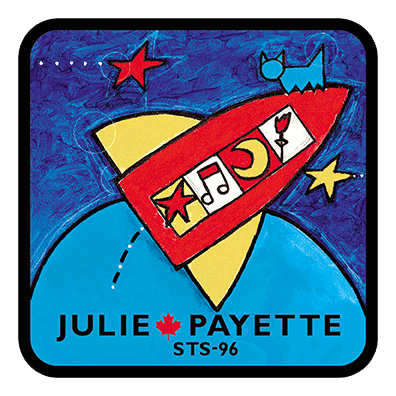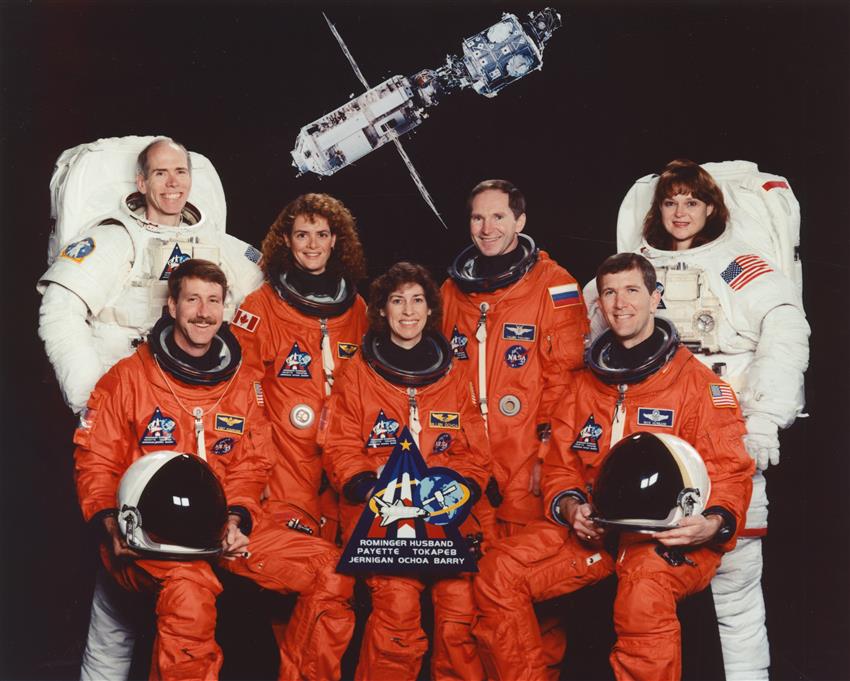Mission STS-96

Mission description

Text version
There exist special places in the "Universe" where art and science meet and where souls merge. From these magic moments, inspiration is born.
"La fusée de Julie" is a celebration of mankind, nature, the joy of living and of a child that sleeps, and occasionally stirs, within us.
This crest commemorates mission STS-96, Canadian Space Agency (CSA) astronaut Julie Payette's first space mission. Taking place from May 27 to June 6, 1999 aboard Space Shuttle Discovery, Julie partook in the assembly of the International Space Station (ISS).
The crest is an allegory of human space exploration. For nearly four decades, powerful rockets have carried human beings into orbit to expand the frontiers of knowledge (stars), observe and survey our planet's environment (flower), and prepare us for the future (moon crescent). The musical note reminds us that as humans, we are remarkable for our creativity, our sensibility and our ability to adapt. The cat symbolizes the ground support teams and all friends, colleagues and supporters, without whom space missions would be impossible. Finally, Earth is represented here without boundaries to emphasize the international nature of space endeavors at the end of this century, as well as to remind us that the blue planet is still the only known habitable place for humans. It is our collective responsibility to take care of it.
This crest was designed by Quebec artist Gérard Dansereau.
Patch STS-96. (Credit: Canadian Space Agency)
Launch
Date: May 27, 1999
Time: 6:49:42 a.m. ET
Site: Kennedy Space Center
Landing
Date: June 6, 1999
Time: 2:02:43 a.m. ET
Site: Kennedy Space Center
Mission duration: 9 days 19 h 13 min 57 s
Flight number: STS-96
Orbiter vehicle: Discovery
Payloads: ISS-2A.1 (Logistics and Outfitting), SPACEHAB (Double module), The SPACEHAB is a large, Integrated Cargo Carrier (ICC), STARSHINE, Shuttle Vibration Forces (SVF), Integrated Vehicle Health Monitoring system (IVHM).
On May 27, 1999 at 6:49 a.m. ET, Space Shuttle Discovery was launched from the Kennedy Space Center carrying an international crew of seven astronauts. On their third day of flight, the crew of STS-96 made history when the shuttle docked for the first time with the International Space Station (ISS). Canadian Space Agency astronaut Julie Payette had the distinction of becoming the first Canadian to board the Station.
STS-96 delivered a slew of equipment to the ISS (such as stowage racks, computers, medical and sanitary equipment, etc.) all vital to making the Station—consisting at that time of only the Zarya and Unity modules—a habitable orbital outpost. External equipment was also installed, including construction tools as well as two cranes from the shuttle's cargo bay.
Among her many tasks, Julie Payette had the opportunity to test the Canadarm's Space Vision System, a Canadian-made technology.

Mission STS-96 crew
From left to right. Daniel T. Barry, Kent V. Rominger, Julie Payette, Ellen Ochoa, Valery Tokarev, Rick D. Husband, Tamara E. Jernigan. (Credit: NASA)